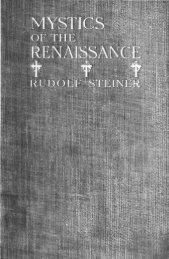The Supreme Doctrine - neo-alchemist
The Supreme Doctrine - neo-alchemist
The Supreme Doctrine - neo-alchemist
You also want an ePaper? Increase the reach of your titles
YUMPU automatically turns print PDFs into web optimized ePapers that Google loves.
HOW TO CONCEIVE THE INNER TASK<br />
either somatic or psychic, but which will engender physico-chemical<br />
movements and imaginations.<br />
When attention is thus fixed a vicious circle is necessarily established;<br />
the imaginations which result from the process at once act as stimulants<br />
which cause new forces to spring up whose fate is identical with that of the<br />
preceding force etc....<br />
On the contrary, if my attention, at first fixed on the exciting outer<br />
world, turns back thereafter internally towards the informal force at the point<br />
of its initial springing-forth, and remains there for a moment, during that<br />
moment the vital energy escapes from the disintegrating mechanism of form,<br />
and it does not produce any movement of my machine, either actions or<br />
thoughts. On the other hand it does not return to its source, for the first<br />
disintegration which has given it birth is irreversible. What becomes of it?<br />
Certain doctrines, insufficiently freed from the fascination of form, teach that<br />
this force accumulates in the total form of the organism, but different from<br />
that which we know, more subtle, and that it constitutes thus little by little a<br />
second body, which is subtle, within the first body, which is gross (illusory<br />
theory of an 'astral body'). Zen, which anyhow does not 'believe' in anything,<br />
does not believe in that. How can we then conceive the destiny of this pure<br />
vital energy, saved from phenomenal disintegration, in the light of Zen<br />
thought? We can suppose that this energy accumulates in us indeed, but not<br />
within a form, however subtle one may wish to imagine it; it accumulates<br />
without form on the plane of the two inferior creative principles, positive and<br />
negative, principles which although giving birth to all forms are themselves<br />
in-formal. It accumulates there and could be qualified as potential, actualised<br />
energy; as potential energy, it no more acts, phenomenally, than potential<br />
energy acts when at its source; but, actualised, it accumulates for ulterior<br />
action. This ulterior action is satori. Vital energy is comparable with an<br />
explosive powder which, without co-ordinating action from within, burns<br />
packet by packet in simple fireworks, powerless to change the structure of the<br />
being (these fireworks are our emotions and their psycho-somatic effects).<br />
<strong>The</strong> inner work from time to time saves a certain quantity of this powder and<br />
stores up these little packets, manufacturing thus a kind of delayed-action<br />
bomb. This bomb will only burst when a sufficient quantity of the powder<br />
has thus been accumulated. But this delayed explosion will have nothing in<br />
common with the emotional fireworks; while the emotions used the human<br />
organism because these little explosions occurred within the form of this<br />
107




